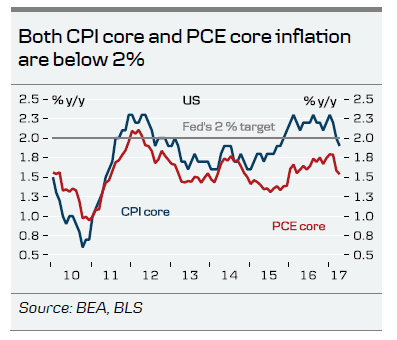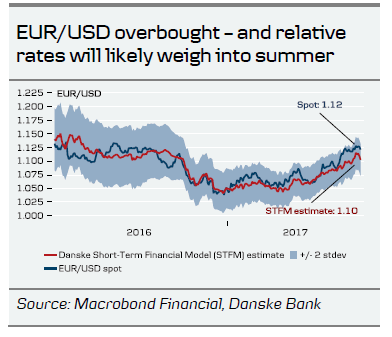- We stick to our view that the Fed will skip hiking at the upcoming meeting and instead announce the triggers for quantitative tightening (QT), as a datadependent Fed should wait at least one meeting to confirm that recent weakness is only temporary.
- However, given the high expectations of a June hike, the Fed may have painted itself into a corner, as high expectations have weighed on the Fed’s decision before.
- If the Fed hikes in June, we do not expect an announcement on QT. Instead, we expect it to be postponed until the September meeting. We still think the third hike is most likely in December.
- We expect unchanged ‘dots’ signalling three hikes per year and see limited chance of a hawkish surprise.
- We target EUR/USD at 1.09 in 3M and expect only modest impact on Treasury yields from QT.
Unchanged dots
Next week’s meeting is one of the so-called big meetings, which means that we get updated projections and there will be a press conference after the meeting. We will pay particular attention to the ‘dots’. We believe the ‘dots’ will be unchanged signalling a hiking pace of three hikes per year, which is also part of the reason why we do not think the Fed will want to hike at this meeting since it would signal four hikes this year – more on this below. Furthermore, we believe the estimate of the long-run interest rate will be 3%. NAIRU and inflation estimates are also interesting. The NAIRU estimate is interesting, as the Fed’s latest estimate of NAIRU was 4.7% and the unemployment rate has recently hit 4.3%. The projection for inflation is interesting given the recent sharp fall in inflation
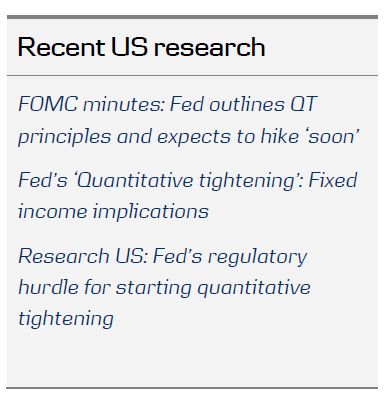
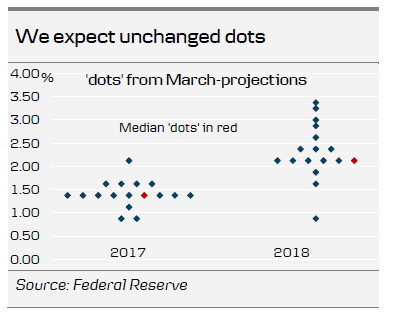
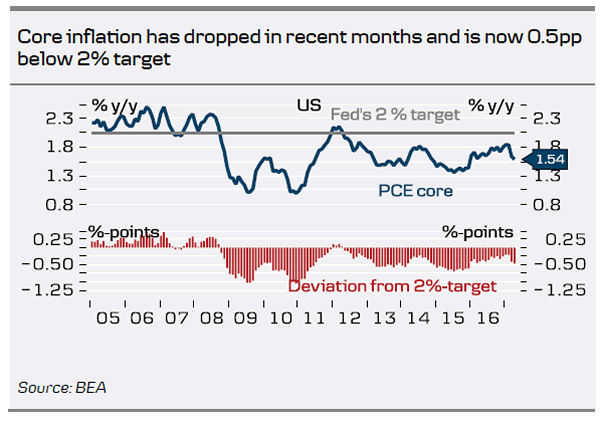
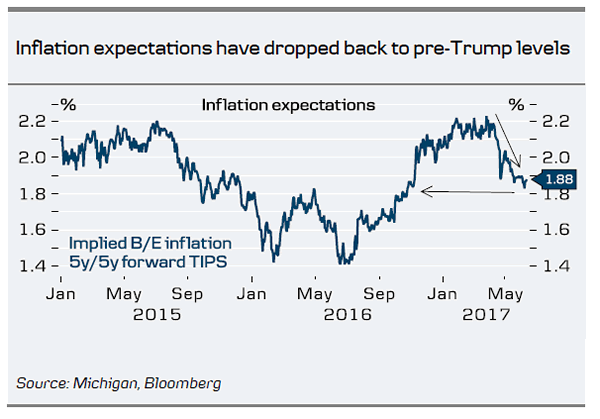
Data-dependent Fed should wait at least one meeting
For a long time we have held the view the Fed would skip hiking in June and instead announce the triggers for quantitative tightening. One reason has been the Fed’s desire to start quantitative tightening this year while avoiding a new round of ‘taper tantrum’, meaning the FOMC members want to announce the details well in advance. Another was that the hiking cycle would be smoother by waiting until July, assuming the Fed wants to hike three times this year as signalled both in December and in March (by hiking in both March and June, the Fed has hiked every other meeting since December, implying a hike pace of four per year). However, given the high expectations of the Fed delivering, it may have painted itself into a corner, as high expectations have weighed on the Fed’s decision before although we do not expect a possible June hike to be unanimous.
We are a bit worried about the Fed hiking already again here in June (especially after the hike in March, which came out of the blue), as we do not think the data support it. While the unemployment rate fell to a new cycle low of 4.3% in May, it was for the wrong reason, as the labour force fell – employment growth has declined to the lowest level since 2012. Inflation has disappointed in recent months, inflation expectations have declined since the March meeting and wage growth is still missing despite the tighter labour market. The US surprise index has fallen back to neutral. GDP growth disappointed in Q1, possibly partly due to negative residual seasonality, but we do not know whether growth has accelerated here in Q2. Also, it seems less likely that Trump will deliver on his promises on tax reform and infrastructure investments, meaning that growth will not be boosted by Trumponomics. Although most FOMC members have not incorporated more expansionary fiscal policy in their projections (some have partly), sentiment has begun to decline again both among consumers and businesses.
A Fed hike in June would mean that it is not as data dependent as we thought or the Fed puts more weight on the unemployment rate than we estimated. By waiting until July the FOMC members will get a few more data points to support their views that the recent weakness is temporary and additionally they show markets that every meeting is in fact live, although even July may turn out to be soon. While markets seem convinced the Fed is going to hike in June, it is interesting investors have priced out the number of hikes further out even since the surprising hike in March. By hiking this fast, there is a risk that the Fed may need to pause its hiking cycle and we think risks are skewed towards fewer hikes than the three hikes per year regime, which is our current base case.
In the statement from the May meeting, the Fed communicated that ‘ahead of future adjustments to the target range for the federal funds rate, the Committee will assess realized and expected economic conditions relative to its objectives of maximum employment and 2 percent inflation’. If the Fed is serious about this, the recent, and rather significant, decline in PCE inflation speaks in favour of postponing a hike and seeing whether this downtick is temporary or permanent before continuing to hike. EUR/USD: Fed to fuel a negative summer cocktail
With a Fed that is poised to confirm its determinedness to move on with both hikes and balance-sheet reduction – irrespective of whether a June hike is delivered or not – we expect dollar strength to return temporarily into the summer as the market is currently priced very soft beyond 2017. Although the Fed may eventually have to slow down on its proposed tightening package, we deem that complacency in US rates recently makes for a period of upside to USD crosses from a relative-rate angle.
Ample USD liquidity following the US Treasury Q1 cash deluge has also led to narrowing of the EUR/USD XCCY basis – a factor we reckon has been supportive for EUR/USD during H1 this year. However, with the Fed likely to make an announcement, or at least provide further details, on its planned reduction of its balance sheet focus in the market will return to USD liquidity which is prone to become scarcer during H2. In Research US – Fed’s regulatory hurdle for starting quantitative tightening we highlighted an optimistic scenario for reducing the balance sheet to be one which targets a total reduction of around USD1,700bn over five years that would amount to an average monthly reduction of USD30bn. We stick to that view, which means that if the Fed presents something along those lines we see a risk of the start of an unwarranted tightening of USD liquidity over the coming 3-12M depending on the timing of the start of the reduction. That should widen the EUR/USD XCCY basis and be a negative contributing factor for EUR/USD. In particular, if reductions to a greater extent target Fed’s holdings of mortgage-backed securities.
For EUR/USD, a hawkish stance from the Fed would come at a time where the ECB has admittedly moved a tad closer to ‘neutral’ on rates but at the same time laid out an inflation outlook that deters Draghi and co from looking for an easing exit any time soon. In our view, this makes for a period where EUR/USD could move to the lower end of its newfound 1.08-1.13 range. Should the Fed refrain from hiking in June, the knee-jerk reaction will most likely be to send EUR/USD higher, but we do not expect a move much above the 1.13 level. However, in our base case that a summer hike will come – if not June, then July – we think that as markets digest the boldness with which we think the FOMC will move near term, USD strength will materialise for a while. Add the risk of a slowing eurozone growth momentum in coming months and you have a EUR/USD negative summer cocktail. We remain tactically short the pair in the Danske FX Trading Portfolio and target EUR/USD at 1.09 in 3M. That said, we still see levels below 1.10 as attractive for positioning for a renewed uptick towards the end of the year.
We expect modest spill-over to Treasury yields from QT
The latest minutes stated that quantitative tightening will be conducted ‘in a gradual and predictable manner’. The staff proposes that the FOMC announces a set of gradually increasing caps/limits on the dollar amounts of bonds that will be allowed to run off each month and only reinvest the amounts that exceeded the caps each month. The caps will be set at low levels and then raised every three months (corresponding to every other meeting, although the Fed will likely not vote on this every month, as many FOMC members have argued it should run in the background). When the final values of the caps are reached, the caps will be maintained and the balance sheet will continue to shrink until the target is reached. In the minutes, it was also noted that the approach would ‘likely be fairly straightforward to communicate’. Besides, the ongoing caps/limits ‘could help mitigate the risk of adverse effects on market functioning or outsized effects on interest rates’.
In our view, the spill-over to Treasury yields from a reduction in the Federal Reserve’s balance sheet by phasing out or ceasing reinvestments of the MBS prepayments and/or scheduled repayment of principals should be modest. That said, the potential steepening pressure induced by phased out or ceased reinvestments of maturing Treasuries relies heavily on the Treasury’s issuance pattern going forward, but should be moderate compared to the ‘taper tantrum’ in 2013. Besides, a too excessive quantitative tightening could lead to temporary tightening of financial conditions, offsetting a potential steepening pressure (for more see Fed’s ‘Quantitative Tightening’ Fixed Income Implications, 6 April 2017).
